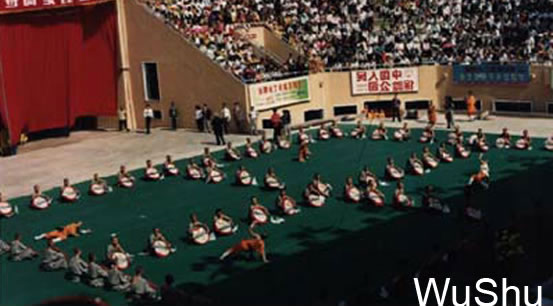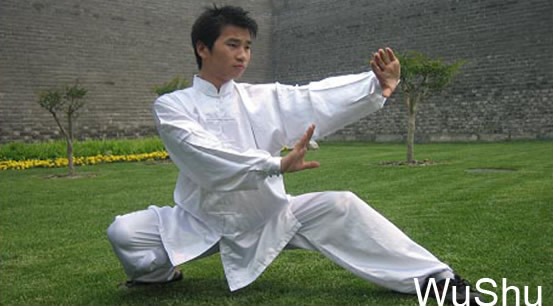Modern Wu Shu is the national sport of China. The term wushu consists of two Chinese characters (wu), meaning "War Art", martial or military, and (shù), which translates into art, skill or method. Together these form "wushù" or "martial art".
Wushu, also known as modern wushu or contemporary wushu, is both an exhibition and a full-contact sport derived from traditional Chinese martial arts. Created in the People's Republic of China after 1949, wushu has spread globally through the International Wushu Federation (IWUF), which holds the World Wushu Championships every two years; the first World Championships were held in 1991 in Beijing and won by Clark Zhang.

Wushu is composed of two disciplines: taolu (forms) and sanda (sparring) [1]. Taolu forms are similar to gymnastics and involve martial art patterns and manoeuvres for which competitors are judged and given points according to specific rules. The forms comprise basic movements (stances, kicks, punches, balances, jumps, sweeps and throws) based on aggregate categories traditional Chinese martial art style and can be changed for competitions to highlight one's strengths. Competitive forms have time limits that can range from 1 minute, 20 seconds for the some external styles to over five minutes for internal styles.
Barehanded
- Changquan (Long Fist)
- Nanquan (Southern Fist)
- Taijiquan (Taiji Fist)
Short Weapons
- Dao (single-edged sword)
- Jian (double-edged sword)
- Taijijian (Taiji double-edged sword)
- Nandao (Southern single-edged sword)
Long Weapons
- Gun (Staff)
- Qiang (Spear)
-
Nangun (Southern Staff)
Most events were first set up in 1958. These events are performed using compulsory or individual routines in competition. Compulsory routines are those routines that have been already created for the athlete, resulting in each athlete performing basically the same set. Individual routines are routines that an athlete creates with the aid of his/her coach, while following certain rules for difficulty, number of acrobatics, etc.
In addition to events for individual routines, some wushu competitions also feature dual and group events. The dual event, also called duilian, is an event in which there is some form of sparring with weapons, or without weapons or even using bare hands against weapons. The dual event is usually spectacular and actions are choreographed before hand. The group event, also known as jiti, requires a group of people to perform together and smooth synchronization of actions are crucial. Usually, the group event also allows instrumental music to accompany the choreography during the performance. The carpet used for the group event is also larger than the one used for individual routines.

Previously, international wushu competitions most often used compulsory routines, while high-level competitions in China most often used individual routines. However, after the 2003 Wushu World Games in Macau it was decided to opt for individual routines in international competition with nandu; difficulty movements) added for additional point bonuses.
There is some controversy concerning the inclusion of nandu in wushu because many of the movements created for the specific events are not originally movements used in those styles. In addition the number of injuries which have resulted from the inclusion of these nandu have caused many people to question their inclusion. Those who support the new difficulty requirements follow the assertion that they help to progress the sport and improve the overall physical quality of the athletes.
Another modern form of wushu is called sanda (sometimes called sanshou or Lei Tai), which is a modern fighting method and sport influenced by both traditional Chinese boxing, Chinese wrestling methods called Shuai Chiao and other Chinese grappling techniques such as Qin Na. It has all the combat aspects of wushu. Sanda appears much like kickboxing or Muay Thai, but includes many more grappling techniques. Sanda fighting competitions are often held alongside taolu or form competitions.